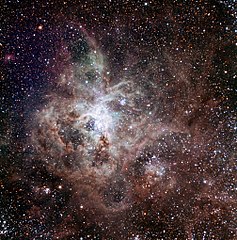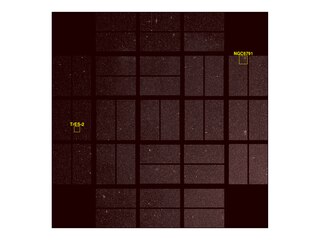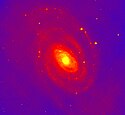Erstes Licht

Als erstes Licht wird in der Astronomie der Augenblick bezeichnet, in dem zum ersten Mal Licht eines Gestirns auf den Spiegel oder die Linse eines neuen Teleskops fällt. Das gilt nicht nur für das Fernrohr selbst, sondern auch für die daran angeschlossenen Instrumente, denen man ihr jeweils eigenes Erstes Licht zuspricht. Analog spricht man vom ersten Licht eines Radioteleskops, wenn dieses zum ersten Mal Radiowellen empfängt, und die Empfänger in verschiedenen Wellenbereichen können jeweils ihr eigenes erstes Licht haben.
Bei der Inbetriebnahme von Lasern wird der Ausdruck für das erste erzeugte Licht verwendet, noch bevor der Laser mit seiner maximalen Leistung betrieben wird.
Der Begriff wird im deutschen Sprachraum häufig in der englischen Version first light gebraucht.
Astronomie
Üblicherweise haben Erstes-Licht-Bilder keine hohe wissenschaftliche Bedeutung und sind von geringerer Qualität als spätere Aufnahmen, da das Teleskop oder Instrument noch nicht vollständig justiert ist. Oft werden für das erste Bild sehr bekannte oder spektakuläre astronomische Objekte mit hohem Wiedererkennungswert ausgesucht. Das erste Licht ist im Prinzip nur der erste erfolgreiche Funktionstest für das gesamte System und beweist, dass die Technik funktioniert.
Für die Konstrukteure und Erbauer eines neuen Teleskopes ist der Augenblick des „first light“ ein spannendes und wichtiges Ereignis, doch auch für größere Teile der astronomischen Fachwelt. Insbesondere das Erste Licht eines neuen Fernrohrtypus – wie 2007 jenes[2] des Large Binocular Telescope – findet meist weltweites Interesse.
Galerie
- (c) TRAPPIST/E. Jehin/ESO, CC BY 4.0
- Teil des Ersten Licht Bildes aus dem NGC 3532 Sternhaufen, aufgenommen 1990 durch die Wide Field/Planetary Camera des Hubble-Weltraumteleskopes. Trotz Hauptspiegelfehler konnten klarere Bilder als mit bodenbasierten Beobachtungen erzielt werden.[4]
- Erstes Licht Bild einer sternreichen Region in den Sternbildern Schwan und Leier, aufgenommen 2009 durch das Kepler Weltraumteleskop.[5]
- Erstes Licht Bild des Sterns HD 84406 im Sternbild Großer Bär, aufgenommen 2022 durch das James-Webb-Weltraumteleskop. Der einzelne Stern ist hier 18 mal zu sehen, da die 18 einzelnen Spiegelsegmente noch nicht kalibriert sind.[1]
- Erstes Licht Bild der Galaxie NGC 5364, aufgenommen 2002 durch das VIMOS Instrument des Very Large Telescope.[6]
- Erstes Licht Bild von Jupiter und der Milchstraße, aufgenommen 2002 durch das WISPR der Parker Solar Probe.[7]
Einzelnachweise
- ↑ a b Photons Received: Webb Sees Its First Star – 18 Times. NASA, 11. Februar 2022, abgerufen am 28. Juni 2022 (englisch).
- ↑ "Erstes Licht" für das Large Binocular Telescope - Das größte und modernste Einzelteleskop der Welt hat die ersten Himmelsaufnahmen geliefert - deutsche Astronomen sind maßgeblich beteiligt. Max-Planck-Gesellschaft, 26. Oktober 2005, abgerufen am 28. Juni 2022.
- ↑ TRAPPIST–South first light image of the Tarantula Nebula. European Southern Observatory, 8. Juni 2010, abgerufen am 28. Juni 2022 (englisch).
- ↑ Hubble's 'First Light'. NASA, 3. Juni 2020, abgerufen am 28. Juni 2022 (englisch).
- ↑ Kepler's First Light. NASA, 8. April 2009, abgerufen am 28. Juni 2022 (englisch).
- ↑ NGC 5364. European Southern Observatory, 12. März 2002, abgerufen am 28. Juni 2022 (englisch).
- ↑ First Light Data for NASA's Parker Solar Probe. NASA, 19. September 2018, abgerufen am 28. Juni 2022 (englisch).
Auf dieser Seite verwendete Medien
Initial imaging of the star HD 84406 by James Webb Space Telescope, after initial alignment, released by NASA on 2022-02-11. At this point, the 18 primary mirror segments are only roughly aligned, so far, and not yet focused. So the image shows 18 blurred copies of the same star. During the following 3 months, the mirrors will be aligned fully, to focus and synchronize their separate images into one complete image.
(c) TRAPPIST/E. Jehin/ESO, CC BY 4.0
This first light image of the TRAPPIST national telescope at La Silla shows the Tarantula Nebula, located in the Large Magellanic Cloud (LMC) — one of the galaxies closest to us. Also known as 30 Doradus or NGC 2070, the nebula owes its name to the arrangement of bright patches that somewhat resembles the legs of a tarantula. Taking the name of one of the biggest spiders on Earth is very fitting in view of the gigantic proportions of this celestial nebula — it measures nearly 1000 light-years across! Its proximity, the favourable inclination of the LMC, and the absence of intervening dust make this nebula one of the best laboratories to help understand the formation of massive stars better. The image was made from data obtained through three filters (B, V and R) and the field of view is about 20 arcminutes across.
This image from NASA's Kepler mission shows the telescope's full field of view -- an expansive star-rich patch of sky in the constellations Cygnus and Lyra stretching across 100 square degrees, or the equivalent of two side-by-side dips of the Big Dipper. A cluster of stars, called NGC 6791, and a star with a known planet, called TrES-2, are outlined. The cluster is eight billion years old, and located 13,000 light-years from Earth. It is called an open cluster because its stars are loosely bound and have started to spread out. TrES-2 is a hot Jupiter-like planet known to cross in front of, or transit, its star every 2.5 days. Kepler will hunt for transiting planets that are as small as Earth.
First light image from the WISPR instrument on Parker Solar Probe in September 2018
Autor/Urheber: ESO, Lizenz: CC BY 4.0
The spiral galaxy NGC 5364 was the first object to be observed with the VIMOS instrument. This false-colour near-infrared raw First Light image reveal extensive structure in the spiral arms of the galaxy.
The image consists of a 60 sec exposure of NGC 5364 on February 26, 2002; image quality 0.6 arcsec FWHM; full moon; field of view 3.5 x 3.5 arcmin2 ; North is up and East is left.
ID: 09e-02
Press Release: 04/02
Object: NGC 5364
Telescope: UT3/Melipal
Instrument: VIMOS
Size: 800x737
Credit: ESO
Cross Identifications: NGC 5317, NGC 5364, UGC 8853, MCG +1-36-3, PGC 49555, CGCG 46-9, IRAS 13536+0515 (Revised NGC Data for NGC 5317)This image is part of the first image taken with NASA's Hubble Space Telescope's (HST) Wide Field/Planetary Camera. All objects seen are stars within open cluster NGC 3532 in the Milky Way galaxy. Stars pictured in the HST frame are sharper than ground telescope images and well resolved, as shown by the double star at the top of the image. By avoiding the Earth's atmosphere, the HST gives sharper images and better resolution. In this early engineering picture, the HST images are roughly 50 percent sharper than the ground-based images.
Technical Details: The first image taken with the HST is intended to assist in focusing the telescope. The region observed is centered on the 8.2 magnitude star HD96755 in the open cluster NGC 3532, in the southern constellation Carina. Identical small subsections of the HST and ground-based image pictures were chosen to highlight the difference in resolution. The field shown is approximately 11 x 14 arcseconds in size and does not contain HD96755.
The HST image is a thirty-second exposure taken by the Wide Field/Planetary Camera. The picture shown was extracted from the area observed by the WF-3 OCD using the F555W broadband filter. The measured width of star profiles (FWFM) gives a good indication of the angular resolution. The FWFM of the stars in the HST picture is about 0.8 arcseconds, compared to 1.1 arcseconds for normal ground telescopes, which points out the remarkable increase in resolution of the HST even at this early stage of the focusing task.










